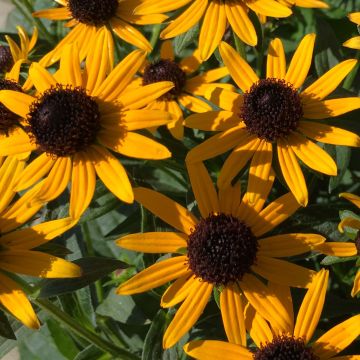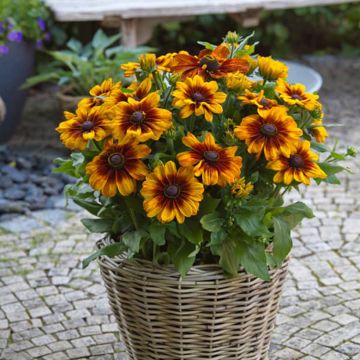

Rudbeckia hirta Summerina Electra Shock
Rudbeckia hirta Summerina Electra Shock
Rudbeckia hirta (x) Echinacea Summerina Electra Shock®
Coneflower
Special offer!
Receive a €20 voucher for any order over €90 (excluding delivery costs, credit notes, and plastic-free options)!
1- Add your favorite plants to your cart.
2- Once you have reached €90, confirm your order (you can even choose the delivery date!).
3- As soon as your order is shipped, you will receive an email containing your voucher code, valid for 3 months (90 days).
Your voucher is unique and can only be used once, for any order with a minimum value of €20, excluding delivery costs.
Can be combined with other current offers, non-divisible and non-refundable.
Why not try an alternative variety in stock?
View all →This plant carries a 12 months recovery warranty
More information
We guarantee the quality of our plants for a full growing cycle, and will replace at our expense any plant that fails to recover under normal climatic and planting conditions.
Would this plant suit my garden?
Set up your Plantfit profile →
Description
Rudbeckia 'Summerina Electra Shock'®, also known by the sweet name 'ET RDB 404', is a surprising and highly ornamental variety. Its narrow and upright petal flowers, around an almost black central cone, are a golden orange-yellow in warm weather and turn brown-bronze as temperatures cool. This Rudbeckia blooms for a long time, from May to November, on a rounded clump of dark green foliage. Give it full sun, in good garden soil that is not too dry or poor, or plant it in a pot.
A must-have in gardens, Rudbeckias belong to the Asteraceae family, just like asters, Centaureas, and yarrows. 'Summerina Electra Shock'® is the result of cross-breeding between a Rudbeckia and an Echinacea. It combines the appearance of Rudbeckia with the hardiness of Echinacea. These two species are native to prairies in the eastern United States, where competition, full sun, and heat are prevalent. They are therefore reliable and very robust plants in the garden. They produce large "sun" flowers throughout the summer, which are actually inflorescences: the peripheral flowers are yellow and attract pollinators, while the central flowers are dark and produce seeds. The tall clump has dark green, elongated, and pointed leaves.
'Summerina Electra Shock'® is distinguished by a fairly compact habit, with a tendency to be rounded, reaching a height of 60cm and a width of 45cm at maturity. Very floriferous, it provides an extra-long flowering period from May to November, with typical species flowers measuring about 10cm in diameter, numerous and borne on strong and branched stems.
Provide Rudbeckias with a well-situated spot in full sun, in ordinary, well-drained, and not too poor soil. They appreciate limestone. While a well-established clump can withstand drought, the flowering will be more beautiful if the soil does not dry out during the summer. Maintenance, which is minimal, simply involves removing faded flowers from time to time. However, you can also leave them for their autumnal charm once they are dry, especially as they then provide a good food source for birds.
Plant 'Summerina Electra Shock'® in a beautiful pot, showcased on the terrace or balcony. In the garden, place it in borders, mixed borders, accompanied by colourful Kniphofias, grasses like Panicum or Pennisetum, salvias, and verbenas. Cut flowers hold up very well in a vase.
Report an error about the product description
Flowering
Foliage
Plant habit
Botanical data
Rudbeckia hirta (x) Echinacea
Summerina Electra Shock®
Asteraceae
Coneflower
Cultivar or hybrid
Other Rudbeckia
View all →Planting and care
Plant Rudbeckia in a sunny location in well-drained, humus-bearing soil. Easy to grow, it requires very little maintenance (simply prune the faded flowers in early November). It can tolerate ordinary soil, even clayey and calcareous soil, as long as it is properly loosened and, above all, remains fresh in summer. It should be planted in a sunny location.
Planting period
Intended location
Care
This item has not been reviewed yet - be the first to leave a review about it.
Similar products
Haven't found what you were looking for?
Hardiness is the lowest winter temperature a plant can endure without suffering serious damage or even dying. However, hardiness is affected by location (a sheltered area, such as a patio), protection (winter cover) and soil type (hardiness is improved by well-drained soil).

Photo Sharing Terms & Conditions
In order to encourage gardeners to interact and share their experiences, Promesse de fleurs offers various media enabling content to be uploaded onto its Site - in particular via the ‘Photo sharing’ module.
The User agrees to refrain from:
- Posting any content that is illegal, prejudicial, insulting, racist, inciteful to hatred, revisionist, contrary to public decency, that infringes on privacy or on the privacy rights of third parties, in particular the publicity rights of persons and goods, intellectual property rights, or the right to privacy.
- Submitting content on behalf of a third party;
- Impersonate the identity of a third party and/or publish any personal information about a third party;
In general, the User undertakes to refrain from any unethical behaviour.
All Content (in particular text, comments, files, images, photos, videos, creative works, etc.), which may be subject to property or intellectual property rights, image or other private rights, shall remain the property of the User, subject to the limited rights granted by the terms of the licence granted by Promesse de fleurs as stated below. Users are at liberty to publish or not to publish such Content on the Site, notably via the ‘Photo Sharing’ facility, and accept that this Content shall be made public and freely accessible, notably on the Internet.
Users further acknowledge, undertake to have ,and guarantee that they hold all necessary rights and permissions to publish such material on the Site, in particular with regard to the legislation in force pertaining to any privacy, property, intellectual property, image, or contractual rights, or rights of any other nature. By publishing such Content on the Site, Users acknowledge accepting full liability as publishers of the Content within the meaning of the law, and grant Promesse de fleurs, free of charge, an inclusive, worldwide licence for the said Content for the entire duration of its publication, including all reproduction, representation, up/downloading, displaying, performing, transmission, and storage rights.
Users also grant permission for their name to be linked to the Content and accept that this link may not always be made available.
By engaging in posting material, Users consent to their Content becoming automatically accessible on the Internet, in particular on other sites and/or blogs and/or web pages of the Promesse de fleurs site, including in particular social pages and the Promesse de fleurs catalogue.
Users may secure the removal of entrusted content free of charge by issuing a simple request via our contact form.
The flowering period indicated on our website applies to countries and regions located in USDA zone 8 (France, the United Kingdom, Ireland, the Netherlands, etc.)
It will vary according to where you live:
- In zones 9 to 10 (Italy, Spain, Greece, etc.), flowering will occur about 2 to 4 weeks earlier.
- In zones 6 to 7 (Germany, Poland, Slovenia, and lower mountainous regions), flowering will be delayed by 2 to 3 weeks.
- In zone 5 (Central Europe, Scandinavia), blooming will be delayed by 3 to 5 weeks.
In temperate climates, pruning of spring-flowering shrubs (forsythia, spireas, etc.) should be done just after flowering.
Pruning of summer-flowering shrubs (Indian Lilac, Perovskia, etc.) can be done in winter or spring.
In cold regions as well as with frost-sensitive plants, avoid pruning too early when severe frosts may still occur.
The planting period indicated on our website applies to countries and regions located in USDA zone 8 (France, United Kingdom, Ireland, Netherlands).
It will vary according to where you live:
- In Mediterranean zones (Marseille, Madrid, Milan, etc.), autumn and winter are the best planting periods.
- In continental zones (Strasbourg, Munich, Vienna, etc.), delay planting by 2 to 3 weeks in spring and bring it forward by 2 to 4 weeks in autumn.
- In mountainous regions (the Alps, Pyrenees, Carpathians, etc.), it is best to plant in late spring (May-June) or late summer (August-September).
The harvesting period indicated on our website applies to countries and regions in USDA zone 8 (France, England, Ireland, the Netherlands).
In colder areas (Scandinavia, Poland, Austria...) fruit and vegetable harvests are likely to be delayed by 3-4 weeks.
In warmer areas (Italy, Spain, Greece, etc.), harvesting will probably take place earlier, depending on weather conditions.
The sowing periods indicated on our website apply to countries and regions within USDA Zone 8 (France, UK, Ireland, Netherlands).
In colder areas (Scandinavia, Poland, Austria...), delay any outdoor sowing by 3-4 weeks, or sow under glass.
In warmer climes (Italy, Spain, Greece, etc.), bring outdoor sowing forward by a few weeks.
























































